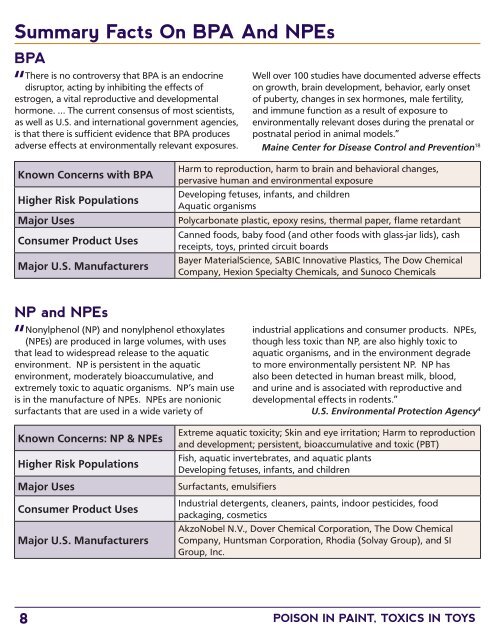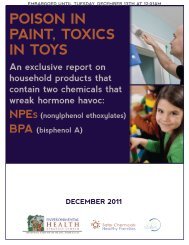POISON IN PAINT, TOXICS IN TOYS - HealthyStuff.org
POISON IN PAINT, TOXICS IN TOYS - HealthyStuff.org
POISON IN PAINT, TOXICS IN TOYS - HealthyStuff.org
Create successful ePaper yourself
Turn your PDF publications into a flip-book with our unique Google optimized e-Paper software.
Summary Facts On BPA And NPEs<br />
BPA<br />
“<br />
There is no controversy that BPA is an endocrine<br />
disruptor, acting by inhibiting the e�ects of<br />
estrogen, a vital reproductive and developmental<br />
hormone. … The current consensus of most scientists,<br />
as well as U.S. and international government agencies,<br />
is that there is su�cient evidence that BPA produces<br />
adverse e�ects at environmentally relevant exposures.<br />
8<br />
Well over 100 studies have documented adverse e�ects<br />
on growth, brain development, behavior, early onset<br />
of puberty, changes in sex hormones, male fertility,<br />
and immune function as a result of exposure to<br />
environmentally relevant doses during the prenatal or<br />
postnatal period in animal models.”<br />
Maine Center for Disease Control and Prevention 18<br />
Known Concerns with BPA<br />
Harm to reproduction, harm to brain and behavioral changes,<br />
pervasive human and environmental exposure<br />
Higher Risk Populations<br />
Developing fetuses, infants, and children<br />
Aquatic <strong>org</strong>anisms<br />
Major Uses Polycarbonate plastic, epoxy resins, thermal paper, �ame retardant<br />
Consumer Product Uses<br />
Canned foods, baby food (and other foods with glass-jar lids), cash<br />
receipts, toys, printed circuit boards<br />
Major U.S. Manufacturers<br />
Bayer MaterialScience, SABIC Innovative Plastics, The Dow Chemical<br />
Company, Hexion Specialty Chemicals, and Sunoco Chemicals<br />
NP and NPEs<br />
“<br />
Nonylphenol (NP) and nonylphenol ethoxylates<br />
(NPEs) are produced in large volumes, with uses<br />
that lead to widespread release to the aquatic<br />
environment. NP is persistent in the aquatic<br />
environment, moderately bioaccumulative, and<br />
extremely toxic to aquatic <strong>org</strong>anisms. NP’s main use<br />
is in the manufacture of NPEs. NPEs are nonionic<br />
surfactants that are used in a wide variety of<br />
Known Concerns: NP & NPEs<br />
Higher Risk Populations<br />
Major Uses Surfactants, emulsi�ers<br />
Consumer Product Uses<br />
Major U.S. Manufacturers<br />
industrial applications and consumer products. NPEs,<br />
though less toxic than NP, are also highly toxic to<br />
aquatic <strong>org</strong>anisms, and in the environment degrade<br />
to more environmentally persistent NP. NP has<br />
also been detected in human breast milk, blood,<br />
and urine and is associated with reproductive and<br />
developmental e�ects in rodents.”<br />
U.S. Environmental Protection Agency 4<br />
Extreme aquatic toxicity; Skin and eye irritation; Harm to reproduction<br />
and development; persistent, bioaccumulative and toxic (PBT)<br />
Fish, aquatic invertebrates, and aquatic plants<br />
Developing fetuses, infants, and children<br />
Industrial detergents, cleaners, paints, indoor pesticides, food<br />
packaging, cosmetics<br />
AkzoNobel N.V., Dover Chemical Corporation, The Dow Chemical<br />
Company, Huntsman Corporation, Rhodia (Solvay Group), and SI<br />
Group, Inc.<br />
<strong>POISON</strong> <strong>IN</strong> PA<strong>IN</strong>T, <strong>TOXICS</strong> <strong>IN</strong> <strong>TOYS</strong>




